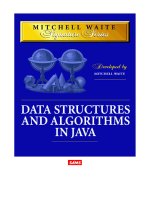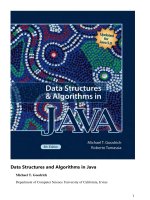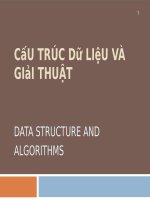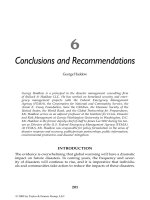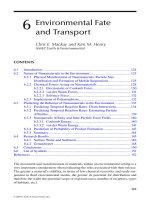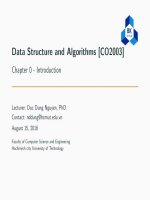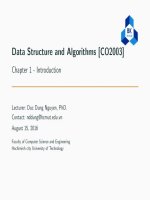Data Structure and Algorithms CO2003 Chapter 6 Tree
Bạn đang xem bản rút gọn của tài liệu. Xem và tải ngay bản đầy đủ của tài liệu tại đây (1.05 MB, 64 trang )
Data Structure and Algorithms [CO2003]
Chapter 6 - Tree
Lecturer: Duc Dung Nguyen, PhD.
Contact:
September 26, 2016
Faculty of Computer Science and Engineering
Hochiminh city University of Technology
Contents
1. Basic Tree Concepts
2. Binary Trees
3. Expression Trees
4. Binary Search Trees
1
Outcomes
• L.O.3.1 - Depict the following concepts: binary tree, complete binary tree, balanced binary
tree, AVL tree, multi-way tree, etc.
• L.O.3.2 - Describe the strorage structure for tree structures using pseudocode.
• L.O.3.3 - List necessary methods supplied for tree structures, and describe them using
pseudocode.
• L.O.3.4 - Identify the importance of “blanced” feature in tree structures and give
examples to demonstate it.
• L.O.3.5 - Identiy cases in which AVL tree and B-tree are unblanced, and demonstrate
methods to resolve all the cases step-by-step using figures.
2
Outcomes
• L.O.3.6 - Implement binary tree and AVL tree using C/C++.
• L.O.3.7 - Use binary tree and AVL tree to solve problems in real-life, especially related to
searching techniques.
• L.O.3.8 - Analyze the complexity and develop experiment (program) to evaluate methods
supplied for tree structures.
• L.O.8.4 - Develop recursive implementations for methods supplied for the following
structures: list, tree, heap, searching, and graphs.
• L.O.1.2 - Analyze algorithms and use Big-O notation to characterize the computational
complexity of algorithms composed by using the following control structures: sequence,
branching, and iteration (not recursion).
3
Basic Tree Concepts
Basic Tree Concepts
Definition
A tree consists of a finite set of elements, called nodes, and a finite set of directed lines, called
branches, that connect the nodes.
a
c
b
e
f
d
g
h
i
4
Basic Tree Concepts
• Degree of a node: the number of branches associated with the node.
• Indegree branch: directed branch toward the node.
• Outdegree branch: directed branch away from the node.
For the node d:
a
• Degree = 4
• Indegree branches: ad
→ indegree = 1
c
b
e
f
d
g
h
• Outdegree branches:
dg, dh, di
→ outdegree = 3
i
5
Basic Tree Concepts
•
•
•
•
The first node is called the root.
indegree of the root = 0
Except the root, the indegree of a node = 1
outdegree of a node = 0 or 1 or more.
a
c
b
e
f
d
g
h
i
6
Basic Tree Concepts
Terms
• A root is the first node with an indegree of zero.
• A leaf is any node with an outdegree of zero.
• A internal node is not a root or a leaf.
• A parent has an outdegree greater than zero.
• A child has an indegree of one.
→ a internal node is both a parent of a node and a child of another one.
• Siblings are two or more nodes with the same parent.
• For a given node, an ancestor is any node in the path from the root to the node.
• For a given node, an descendent is any node in the paths from the node to a leaf.
7
Basic Tree Concepts
Terms
• A path is a sequence of nodes in which each node is adjacent to the next one.
• The level of a node is its distance from the root.
→ Siblings are always at the same level.
• The height of a tree is the level of the leaf in the longest path from the root plus 1.
• A subtree is any connected structure below the root.
8
Basic Tree Concepts
a
Level 0
Branch ad
Level 1
c
b
d
Branch di
Level 2
e
f
g
h
i
• Parents: a, b, d
• Internal nodes: b, d
• Children: b, c, d, e, f, g, h, i
• Siblings: {b, c, d}, {e, f }, {g, h, i}
• Leaves: c, e, f, g, h, i
• Height = 3
9
Basic Tree Concepts
a
Subtree b
c
b
e
Subtree d
f
d
g
h
i
10
Tree representation
a
• organization chart
a
b
c
b
e
d
f
e
f
g
h
i
c
d
• parenthetical listing
a (b (e f ) c d (g h i))
g
h
• indented list
i
11
Applications of Trees
• Representing hierarchical data
• Storing data in a way that makes it easily searchable (ex: binary search tree)
• Representing sorted lists of data
• Network routing algorithms
12
Binary Trees
Binary Trees
A binary tree node cannot have more than two subtrees.
a
Left subtree
Right subtree
b
d
e
f
g
13
Binary Trees Properties
• To store N nodes in a binary tree:
• The minimum height: Hmin = log2 N + 1
• The maximum height: Hmax = N
• Given a height of the binary tree, H:
• The minimum number of nodes: Nmin = H
• The maximum number of nodes: Nmax = 2H − 1
Balance
The balance factor of a binary tree is the difference in height between its left and right subtrees.
B = HL − HR
Balanced tree:
• balance factor is 0, -1, or 1
• subtrees are balanced
14
Binary Trees Properties
Complete tree
N = Nmax = 2H − 1
The last level is full.
a
c
b
e
d
Nearly complete tree
H = Hmin = log2 N + 1
Nodes in the last level are on the left.
g
f
a
c
b
d
e
15
Binary Tree Structure
Definition
A binary tree is either empty, or it consists of a node called root together with two binary trees
called the left and the right subtree of the root.
16
Binary Tree Structure: Linked implementation
node
d a t a <dataType>
l e f t
r i g h t
end node
binaryTree
r o o t
end b i n a r y T r e e
// G e n e r a l d a t a T y e :
dataType
k e y <keyType>
f i e l d 1 <... >
f i e l d 2 <... >
...
f i e l d n <... >
end d a t a T y p e
17
Binary Tree Structure: Array-based implementation
Suitable for complete tree, nearly complete tree.
Figure 1. Conceptual
binaryTree
d a t a <a r r a y o f dataType>
end b i n a r y T r e e
Figure 2. Physical
18
Binary Tree Traversals
• Depth-first traversal (duyệt theo chiều sâu): the processing proceeds along a path from
the root through one child to the most distant descendent of that first child before
processing a second child, i.e. processes all of the descendents of a child before going on
to the next child.
• Breadth-first traversal (duyệt theo chiều rộng): the processing proceeds horizontally from
the root to all of its children, then to its children’s children, i.e. each level is completely
processed before the next level is started.
19
Depth-first traversal
• Preorder traversal
• Inorder traversal
• Postorder traversal
20
Preorder traversal (NLR)
In the preorder traversal, the root is processed first, before the left and right subtrees.
21
Preorder traversal (NLR)
Algorithm preOrder(val root
Traverse a binary tree in node-left-right sequence.
Pre: root is the entry node of a tree or subtree
Post: each node has been processed in order
if root is not null then
process(root)
preOrder(root->left)
preOrder(root->right)
end
Return
End preOrder
22

